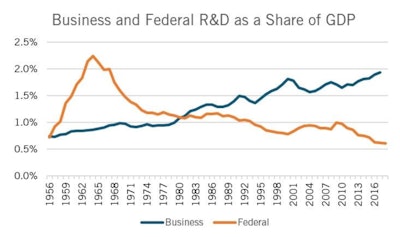
Just about everybody in the U.S. agrees that America must maintain its economic position and stay ahead of China and other foreign competitors by using a strategy of innovation.
In 2015, President Barack Obama said, “America’s future economic growth and international competitiveness depend on our capacity to innovate." His plan, The Strategy for American Innovation, also said, ”Innovation-based economic growth will bring greater income, higher quality jobs and improved health and quality of life to all U.S. citizens, and provides a multifaceted, common sense and sustained approach to ensuring America’s future prosperity."
Basic vs. Applied Research
It is not well known that there are two fundamentally different kinds of research that lead to innovation. The first is basic research, which is generally conducted by the federal government. The second is research and development—also called applied research—which is generally conducted by private firms.
The United States has a long history of investing in federal basic research going back to World War II, when federal research was used to develop radar, electronics, atomic power, jet fighters and many other technologies used to win the war. After the war, the U.S. continued to invest in basic science research, which was used to create many of the technologies and industries we see today.
Basic research differs from research and development because it investigates basic science, is high-risk and seldom results in commercial products in the short-term. Private research and development, on the other hand, uses the new technological ideas and science discovered by basic research to develop new products.
A study published in 2019 in the journal Science shows that one-third of all U.S. patents since 1970 relied on government-funded research. The study was based on an investigation of all patents issued from 1926 to 2017, and underscores the importance of funding basic federal research.
Simply put, public investments in research make private investments in R&D more productive.
The development of new technologies into useful products is accomplished by private companies, but many of these products came, initially, from federal basic research in many fields of science:
- Transistors were not suddenly discovered by the electronics industry; they came from people working with wave mechanics and solid-state physics.
- Light-emitting diode (LED) technology began with the study of infrared emissions from gallium arsenide and other semiconductor alloys.
- Magnetic Resonance Imaging (MRI) came from research into spin echoes, and free induction decay and the study of the movement of atoms.
- Shale gas boom – the boom initially relied on scientific research at the Gas Institute and the geological mapping technology from Sandia labs.
- Browsers – federal research developed the first accessible web browser which was the basis of the Microsoft Internet Explorer and Netscape Navigator browsers.
- Smart phones –many of the components for smart phones came from federal research.
- Google – federal research helped two Stanford graduate students develop the search function in a large data set that led to the Google search engine.
- The Internet came from the development of the defense department ARPANET, including the development of package switching down of electronic messages into smaller packages.
- Artificial Intelligence - public monies have been invested in a range of AI programs, from long-term research into cognition to shorter-term efforts to develop operational systems. Most of the federal support has come from the Defense Advanced Research Projects Agency, the National Institute of Health, National Science Foundation, and National Aeronautics and Space Administration.
The Decline of Basic Research
According to the Information Technology and Innovation Foundation (ITIF), federal basic research has declined 22 out of the last 28 years. The following chart shows that as a percentage of GDP, federal research has fallen from a high of 2.5 percent in 1964 to 0.61 percent in 2016.

This is a serious red flag, as basic research is the foundation of applied research and fundamental to any innovation strategy
Economists have consistently found that innovation and technological change are the most important drivers of productivity growth, and long-term economic growth. The Bureau of Labor Statistics found that "over half of the total increase in productivity comes from innovation and technological progress.
The average annual productivity growth rate is 1.3 percent –well under the average of 2.1 percent going back to 1947. According to the ITIF, “The U.S. government invests less in R&D compared to the size of the economy than it has in more than 60 years…. and counting. There should be no question that it has resulted in stagnant productivity growth, lagging competitiveness and reduced innovation."
There is a high correlation between the investment in basic research and the success of an innovation strategy. According to the ITIF, to match the research levels of the 1980s would require an increase by about 80 percent or $100 billion per year.
The federal report “Rising Above The Gathering Storm Revisited” concluded that "the U.S. appears to be on a course that leads to declining, not growing, standard of living for our children and grandchildren.” The report concluded that, "without a renewed effort to bolster the foundations of our competitiveness we can expect to lose our position.
If we can't invest in the basic research and science that creates the opportunities for new technologies, it is difficult to see how America is going to compete with the Asian countries or remain the number one economy in the world.
Michael Collins is the author of a new book, “Dismantling the American Dream: How Multinational Corporations Undermine American Prosperity.” He can be reached at mpcmgt.net.






















